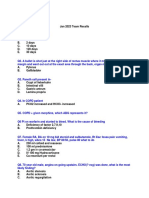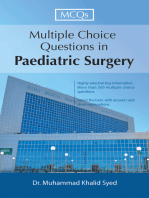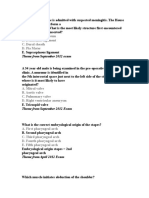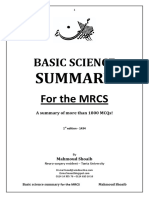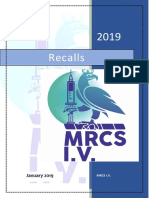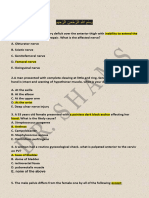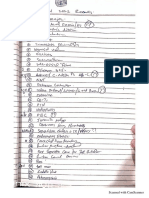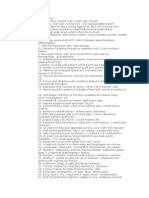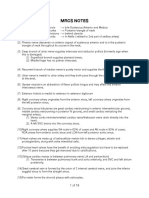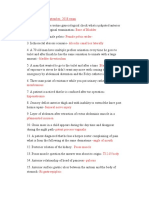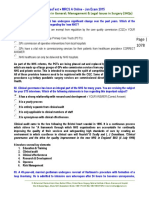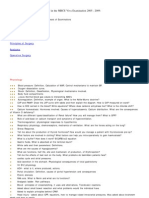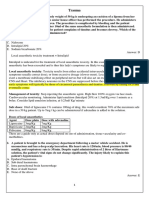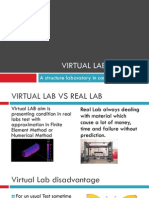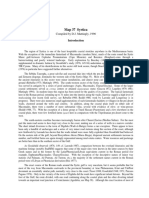April 2019+ans
April 2019+ans
Uploaded by
sohamCopyright:
Available Formats
April 2019+ans
April 2019+ans
Uploaded by
sohamOriginal Title
Copyright
Available Formats
Share this document
Did you find this document useful?
Is this content inappropriate?
Copyright:
Available Formats
April 2019+ans
April 2019+ans
Uploaded by
sohamCopyright:
Available Formats
2019
Recalls
April 2019 MRCS I.V.
MRCS I.V. Course
April 2019 recalls
1. A 26-year-old man presents to the Emergency Department with extensive bleeding from his arm
after sustaining a glass injury. On examination there is a 7 cm transverse laceration across the
anterior aspect of his elbow. On exploring the cubital fossa, you would expect the brachial artery
to be:
A. anterior to the median nerve
B. lateral to the biceps tendon
C. lateral to the median nerve
D. medial to the median nerve
E. superficial to the bicipital aponeurosis
2. A 19-year-old woman presents to the Emergency Department profoundly hypovolemic having
fallen from a horse. A postero-anterior (PA) chest radiograph shows a fracture to the medial third
of the left clavicle. Which of the following vessels is most likely to be damaged?
A. Brachiocephalic trunk
B. Left axillary artery
C. Left common carotid artery
D. Left subclavian artery
E. Left vertebral artery
3. A patient can't dorsiflex his big toe, which nerve root is most likely to be involved?
A. T12
B. L3
C. L5
D. S1
E. S2
4. A Patient fell at his wrist resulting in loss of sensation over the palmar aspect of the lateral 3 and
half fingers. What is the expected injury causing this?
A. Scaphoid fracture
B. Lunate dislocation
C. Distal radial fracture
D. Distal ulnar fracture
E. Hamate fracture
5. A 28-year-old man presents with pain in his left scrotum. A diagnosis of varicocele is made.
Which vessel is involved?
A. Gonadal vein
B. Inferior epigastric vein
C. Pudendal artery
D. Artery of the vas
E. None of the above
Anatomy Recalls 1 MRCS I.V. Course
MRCS I.V. Course
6. During recovery from varicose veins surgery, a 35 years old woman complains of weakness of
dorsiflexion of the ankle. Physical examination reveals absent sensation over the dorsum of the
foot. Which of the following nerves is most likely injured?
A. Common peroneal nerve
B. Deep peroneal nerve
C. Saphenous nerve
D. Superficial peroneal nerve
E. Sural nerve
7. A 70-year-old man undergoes transurethral resection of bladder tumour (TURBT). The tumour
lies over the lateral side wall of the bladder just above the opening of the right ureteric orifice.
Use of the diathermy suddenly causes the patient to 'kick' because of contraction of the hip
adductor's muscles. Which nerve has been stimulated?
A. Femoral nerve
B. Genitofemoral nerve
C. Lateral femoral cutaneous nerve
D. Obturator nerve
E. Sciatic nerve
8. A patient sustained a fracture tibia for which he was put in a cast for 5 weeks. He then developed
severe pain in his leg with pain on plantar flexion. Where would you expect sensory loss?
A. Lateral aspect of the foot
B. Medial aspect of the leg
C. Dorsum of the foot except 1st web space
D. First web space
E. None of the above
9. What is the corresponding dermatome of the little finger?
A. C8
B. C7
C. C6
D. T1
E. C5
10. A patient became unable to dorsiflex his big toe. What is the corresponding spinal root?
A. S1
B. L4
C. L5
D. L3
E. S2
Anatomy Recalls 2 MRCS I.V. Course
MRCS I.V. Course
11. What is the relation of ulnar nerve to the ulnar artery at wrist?
A. Ulnar nerve is ulnar to ulnar artery
B. Ulnar nerve is radial to the ulnar artery
C. Ulnar artery is ulnar to the ulnar nerve
D. Ulnar nerve is lateral to the ulnar artery
E. None of the above
12. A 70-year-old woman from a nursing home is brought to the Emergency Department with
abdominal pain and vomiting. On examination, she is dehydrated, and her abdomen is distended.
There is a 3 cm x 4 cm swelling in the right groin, which is nontender, and there is no cough
impulse. At operation, a femoral hernia is found. Which one of the following lies immediately
lateral to the hernial neck?
A. Femoral artery
B. Lacunar ligament
C. Pectineal ligament
D. Inguinal ligament
E. Femoral vein
13. A 1-year-old girl with a minimally displaced spiral fracture to her tibia, what is the best
management to be done?
A. External fixation
B. Cast from groin to foot
C. Intramedullary nailing
D. Internal fixation with plates
E. None of the above
14. A 30-year-old patient came with sub capital fracture managed by closed reduction, with
excellent prognosis and follow-up, came after 1 year with pain and hip stiffness. What is the
diagnosis?
A. Avascular necrosis
B. malunion
C. Nonunion
D. Osteoarthritis
E. None of the above
15. A 10-year-old boy fall while playing on his outstretched hand, on examination he minimal pain
and swelling at site of injury, what is the type of fracture to be found in x-ray?
A. Transverse
B. Comminuted
C. Oblique
D. Spiral
E. Greenstick
Anatomy Recalls 3 MRCS I.V. Course
MRCS I.V. Course
16. A young male presented with first metatarsal pain, X-ray showed reduced joint space and
subchondral cysts, what's the diagnosis?
A. Pseudo gout
B. Rheumatoid arthritis
C. Gout
D. Osteoarthritis
E. Avascular necrosis
17. A diabetic patient underwent a below knee amputation, then developed a swollen stump,
shortness of breath and chest pain, what is the most likely diagnosis?
A. Pulmonary embolism
B. Gas gangrene
C. Myocardial infarction
D. Pneumonia
E. Cardiac tamponade
18. A diabetic patient underwent a below knee amputation, but the patient developed fever,
swollen red stump and crepitus. What is your provisional diagnosis?
A. Anthrax
B. DVT
C. Gas gangrene
D. Cellulitis
E. None of the above
19. A 50-year-old lady with a long bone fracture, has low Ca level and high ALP. what is the
diagnosis?
A. Paget’s disease
B. Osteoporosis
C. Osteomalacia
D. Metastatic bone tumor
E. Rickets
20. A 75-year-old man presented with backpain for 1 month and irregular urine stream. On PR
examination he has hard prostate mass, his PSA is more than 300. What is the first line of
treatment regarding his state?
A. Hormonal therapy
B. Radiotherapy
C. Watchful waiting
D. Radical prostatectomy
E. Orchiectomy
Anatomy Recalls 4 MRCS I.V. Course
MRCS I.V. Course
21. A patient with absent dorsalis pedis and posterior tibial artery pulses after RTA. He has no
sensation below knee, and his leg was internally rotated. What is the likely cause?
A. Neck of femur fracture
B. Posterior hip dislocation with sciatic nerve injury
C. Anterior hip dislocation
D. Fracture distal femur
E. None of the above
22. A 25 years old athlete came with a single rib fracture. He is in pain, but he is vitally stable. What
is the most appropriate management?
A. Chest drain
B. Admission, observation and analgesia
C. Analgesia and discharge
D. Infiltration of wound with 5% bupivacaine
E. None of the above
23. A 59 years old COPD patient came with a rib fracture. X-ray was done with no hemo or
pneumothorax detected, but the patient is in pain. What is the most appropriate management?
A. Chest drain
B. Admission, observation and analgesia
C. Analgesia and discharge
D. Infiltration of wound with 5% bupivacaine
E. None of the above
24. A 34 years old patient presented after chest trauma. The trauma affected the ribs from 5th to
10th which were fractured. The patient is cyanosed and tachycardic. What is the most
appropriate management?
A. Chest drain
B. Admission, observation and analgesia
C. Analgesia and discharge
D. Infiltration of wound with 5% bupivacaine
E. None of the above
25. A 32 years old athlete patient presented with restrictive movement of whole spine at all
regions. He denies any history of trauma. What is the most likely cause?
A. Ankylosing spondylitis
B. Spondylolisthesis
C. Spondylolysis
D. Spinal canal stenosis
E. Spina bifida
Anatomy Recalls 5 MRCS I.V. Course
MRCS I.V. Course
26. A 45 years old male presented with frequency and urgency. On cystogram and after voiding, he
feels incomplete emptying. He was found to have increased intravesical pressure with residual
volume of 200ml. What is the most likely cause?
A. BPH
B. Bladder outlet obstruction
C. Bladder diverticulum
D. Urethral stenosis
E. Underactive bladder
27. A 49 years old female has nephrostomy for infected hydronephrosis 3 months ago. She is now
undergoing hysterectomy for a fibroid. What is the best investigation for follow up of
hydronephrosis?
A. Antegrade urethrogram
B. Retrograde urethrogram
C. CT abdomen
D. MRI
E. USS
28. The most common reported infection transmitted by needle prick is:
A. Hepatitis C
B. Hepatitis B
C. HIV
D. Herpes simplex virus
E. CMV
29. A 6-year-old boy brought by his mother with a scrotal swelling which disappears on lying down.
What is the most likely cause?
A. Patent processus vaginalis
B. Undescended testis
C. Direct inguinal hernia
D. Epidydimal cyst
E. None of the above
30. An 8 years old child presented with right leg fracture. Onion peal appearance was detected in x-
ray. What is the most likely diagnosis?
A. Stress fracture
B. Osteosarcoma
C. Multiple myeloma
D. Ewing sarcoma
E. Paget’s disease of bone
Anatomy Recalls 6 MRCS I.V. Course
MRCS I.V. Course
31. A young lady suddenly fell after feeling a sudden pain in the back of her ankle while walking.
What is the test to be positive?
A. Thomas test
B. Phalen test
C. Simmonds Thompson test
D. Froment test
E. Retropulsion test
32. A 35 years old female sustained urinary incontinence obstructed labor. Which nerve root is
responsible?
A. S1, S2, S3
B. S2, S3, S4
C. S3, S4, S5
D. L5,S1,S2
E. L4,L5,S1
33. A 53 years old man presented with painless hematuria and weight loss. Investigations revealed
a urinary bladder mass. What is the most probable histological finding you would expect?
A. Urothelial cell carcinoma
B. Squamous cell carcinoma
C. Adenocarcinoma
D. Signet ring carcinoma
E. None of the above
34. What is the motor nerve supply of dorsal interosseous muscle of the ring finger?
A. Recurrent median nerve
B. Anterior interosseus nerve
C. Deep branch of radial nerve
D. Posterior interosseus nerve
E. Deep ulnar nerve
35. An athlete suffered RTA resulting in a medially rotated thigh with a large swelling at the
midthigh. What is the most likely underlying diagnosis?
A. Neck of femur fracture
B. Posterior hip dislocation with sciatic nerve injury
C. Anterior hip dislocation
D. Fracture shaft femur
E. None of the above
Anatomy Recalls 7 MRCS I.V. Course
MRCS I.V. Course
36. A patient is unable to medially rotate the thigh. What is the affected nerve?
A. Superior gluteal nerve
B. Inferior gluteal nerve
C. Femoral nerve
D. Sciatic nerve
E. Pudendal nerve
37. A 53 years old man fell on his left forearm. On examination, there’s numbness over the first
dorsal web space of hand. Which nerve is involved?
A. Posterior interosseus nerve
B. Superficial ulnar nerve
C. Radial nerve
D. Palmar branch of median nerve
E. Anterior interosseus nerve
38. A 53 years old diabetic hand worker presented with a fixed bent left ring finger. Extending the
finger produces a popping sound. What is the most likely diagnosis?
A. Rheumatoid arthritis
B. Carpal tunnel syndrome
C. Trigger finger
D. Heberden disease
E. None of the above
39. What is the spinal route value of tibial nerve?
A. L4-S3
B. L2-4
C. S2,3,4
D. L3,4
E. L2,3
40. In popliteal fossa, what is accurate relation of popliteal artery?
A. Most lateral, most deep
B. Most medial, most superficial
C. Most medially, most deep
D. Most lateral, most superficial
E. None of the above
Anatomy Recalls 8 MRCS I.V. Course
MRCS I.V. Course
41. A 45-year-old man presents with backache and leg pain due to a prolapsed lumbar
intervertebral disc. The pain, which is aggravated by coughing and sneezing, radiates to the
lateral aspect of the foot. On examination, there is weakness of the plantar flexors of the foot,
which nerve root is most likely to be involved?
A. L5
B. L4
C. S1
D. L3
E. None of the above
42. A 42 years old woman has a cholecystectomy and develops a self-limiting postoperative wound
infection. By what process would bacterial ingestion have been enhanced?
A. Apoptosis
B. Autophagy
C. Metaplasia
D. Opsonization
E. Phagocytosis
43. A 58-year-old woman presented to the Emergency Department with a large fluctuant swelling
at the site of a recent insect bite. She is anxious, tachycardic, and pyrexia. ECG shows critical
fibrillation. She is noted to have a goiter. The swelling at the site of the bite requires surgical
drainage. Which of the following classes of drug would be most appropriate as part of her
preoperative preparation for surgery?
A. Alpha-1 adrenoceptor agonist
B. Alpha-2 adrenoceptor agonist
C. Alpha adrenoceptor blocker
D. Beta adrenoceptor agonist
E. Beta adrenoceptor blocker
44. A 45-year-old man has established cirrhosis. At a follow-up appointment a palpable spleen four
fingers breadths below the costal margin is noticed. Full blood counts have shown a persistent
thrombocytopenia. Bone marrow examination shows megakaryocyte hyperplasia. What is the
most likely cause of the thrombocytopenia?
A. Ineffective production in the bone marrow
B. Platelet destruction in the bone marrow
C. Platelet destruction in the liver
D. Platelet destruction in the spleen
E. Platelet storage in the spleen
Anatomy Recalls 9 MRCS I.V. Course
MRCS I.V. Course
45. Patient with graves' disease came after 12 months with relapse. what to give her now?
A. Propylthiouracil
B. Propranolol
C. Steroids
D. Carbimazole
E. None of the above
46. A young man stabbed in the Left 5th ICS, he is vitally stable apart of tachycardia, normal chest
x-ray, what is the next step to do?
A. Echocardiogram
B. Ct scan
C. thoracotomy
D. insert chest drain
E. MRA
47. An 18-year old woman recently started the combined oral contraceptive pill and present with
acute abdominal pain, vomiting and muscle weakness on examination she has a pulse rate of
86beat/minute and her blood pressure is 160/85 mmHg other findings are:
Result Normal
Serum amylase 110 IU/L <100
Serum ALT (alanine transferase) 22 IU/L <50
Alkaline phosphatase 102 IU/L 50-120
Albumin 41 g/L 35-50
Gamma GT 37 IU/L <60
Bilirubin 10 mol/L 0-20
calcium 2.41 mmol/L 2.20-2.70
Plasma glucose 5.0 mmol/L
Triglycerides 1.5 mmol/L <1.7
What is the most likely diagnosis?
A. Acute intermittent porphyria
B. Diabetic ketoacidosis
C. Hypoparathyroidism
D. Mumps
E. Pancreatitis
Anatomy Recalls 10 MRCS I.V. Course
MRCS I.V. Course
48. A 20-year-old woman presents acutely with abdominal pain. Imaging reveals a right ovarian
cystic lesion which is excised. Histological examination shows a cyst lined by keratinizing
stratified squamous epithelium. Areas of fat, muscle, thyroid and neural tissue are seen in the
wall. What is the appropriate pathological designation for this lesion?
A. Cystadenoma
B. Dysgerminoma.
C. Mesenchymoma
D. Squamous cell carcinoma
E. Teratoma
49. A 33-year-old lady with breast implant and she was worried as she has a strong family history of
breast carcinoma, how to screen for breast cancer?
A. MRI
B. US
C. Mammography
D. FNAC
E. None of the above
50. A 23-year-old girl presented with lump in her right breast. How to investigate for this lump?
A. Mammography
B. U/S
C. MRI
D. X-RAY
E. FNAC
51. A 33 years old lactating female presented with breast swelling and redness not responding to
antibiotics. what is your provisional diagnosis?
A. Inflammatory breast malignancy
B. Cellulitis
C. Lactational mastitis
D. Duct ectasia
E. Breast T.B
52. Which of the following is a breast cancer marker?
A. CEA
B. CA 72-9
C. HIAA
D. Chromogranin A
E. None of the above
Anatomy Recalls 11 MRCS I.V. Course
MRCS I.V. Course
53. A 33 years old patient had splenectomy. What to give her as post splenectomy vaccines?
A. Streptococcus pneumonia vaccine.
B. Streptococcus pneumoniae, Hemophilus influenzae type B vaccines.
C. Streptococcus pneumoniae, Hemophilus influenzae type B, and Neisseria meningitides
vaccines
D. Streptococcus pneumoniae, Hemophilus influenzae type B, and Neisseria meningitides
Vaccines and penicillin
E. None of the above
54. A Chinese lady has conductive hearing loss, palatine ulcer and cervical lymphadenopathy, most
likely diagnosis could be?
A. Nasopharyngeal carcinoma
B. Oropharyngeal carcinoma
C. TB
D. Infectious mononucleosis
E. Maxillary sinusitis
55. A 9-year-old infant presented with fever and tender red mass below angle of mandible what is
your diagnosis?
A. Submandibular abscess
B. Branchial cyst
C. Sebaceous cyst
D. Submandibular gland tumor
E. None of the above
56. A 66 years old patient has lung cancer, during his metastasis work up, their were brain
Metastatic lesions What is the best drug to give for him?
A. Dexamethasone
B. Radiotherapy
C. NSAID
D. Morphine
E. Mannitol
57. A previously fit 21-year-old man collapses while running a Marathon. Resuscitations
unsuccessful a pos-mortem examination shows an intracranial hemorrhage. what is the most
likely site of the hemorrhage?
A. Intraventricular hemorrhage
B. Chronic sub Dural bleed
C. Acute sub Dural bleed
D. Extra Dural hemorrhage
E. Subarachnoid hemorrhage
Anatomy Recalls 12 MRCS I.V. Course
MRCS I.V. Course
58. A patient hit by stick, has depressed skull fracture, with no vomiting or loss of
consciousness. What is the next step?
A. CT within 2 hours
B. CT within 8 hours
C. call neurosurgeon
D. admission under observation
E. craniotomy
59. A patient came after RTA, his GCS was less than 10, after log rolling, he suddenly became
hypoxic with rapid decrease in po2 what is your explanation?
A. Respiratory center depression
B. Spinal cord injury
C. Tracheal tube displacement
D. Pneumothorax
E. Large amount of hemorrhage
60. Post splenectomy, what is the blood component affected firstly in CBC?
A. Platelets causing thrombocytosis
B. Platelets causing thrombocytopenia
C. Reticulocytes
D. Eosinophils
E. Granulocytes
61. A 45-year-old homeless man presents with a cough and weight loss over three months. On
examination his BMI (Body Mass Index) is 19 and he has reduced breath sounds in the right
upper zone. His chest X-ray shows a caveating lesion in the right upper lobe. He undergoes a
bronchoscopy and a bronchial biopsy. The biopsy shows featureless necrosis surrounded by
epithelioid macrophages and giant cells. Which of the following is the most likely diagnosis?
A. Actinomycosis
B. Bronchiectasis
C. Sarcoidosis
D. Squamous cell carcinoma
E. Tuberculosis
Anatomy Recalls 13 MRCS I.V. Course
MRCS I.V. Course
62. A 30-year-old woman presents to the general surgical clinic with a 1.5 cm cervical lymph node
along the anterior border of sternocleidomastoid muscle. Clinical examination and routine blood
tests are unremarkable. She undergoes an excisional biopsy of the lump as a day case. The
histology report reveals encapsulated infiltrative carcinoma with marked fibrosis and cystic
changes within the lymph node. What is the most likely primary pathology?
A. Papillary thyroid carcinoma
B. Follicular thyroid carcinoma
C. Anaplastic thyroid cancer
D. Lymphoma
E. Medullary thyroid cancer
63. A 22-year-old man has been stabbed in the left fifth intercostal space at the edge of the
sternum. Which structure is most likely to have been penetrated?
A. Left atrium
B. Left lobe of the liver
C. Left ventricle
D. Right atrium
E. Right ventricle
64. A 30-year-old man is admitted to the intensive care unit with an isolated severe head injury. A
CT scan shows multiple intracerebral bleeds but no midline shift. He is intubated and ventilated.
His pupils are dilated and react sluggishly to light. His heart rate is 50 beats/minute blood
pressure 170/110 mmHg and his respiratory rate is set at 10 breaths/minute. The rising blood
pressure is likely to be caused by:
A. aortic and carotid baroreceptor stimulation
B. Cortisol stimulation
C. renin-angiotensin stimulation
D. sympathetic stimulation related to blood loss
E. sympathetic stimulation related to intracranial pressure
65. A 62-year-old woman presents to her General Practitioner with a two-week history of back
pain. She has lost 8 cm in height over the last five years Investigations revealed Findings:
Results Normal
Corrected calcium 2.78 mmol/L 2.15- 2.55 mmol/L
Phosphate .84 mmol/L .8 -1.4 mmol/L
GFR .96 ml/min More than 90
PTH 8.9 pmol/L .95 -5.7
A. Secondary hyperparathyroidism
B. Tertiary hyperparathyroidism
C. Hypoparathyroidism
D. Osteoporosis
E. Primary hyperparathyroidism
Anatomy Recalls 14 MRCS I.V. Course
MRCS I.V. Course
66. The right and left pulmonary arteries are derived from which of the following embryological
aortic arches? (ductus arteriosus as well-new)
A. Second aortic arch
B. Third aortic arch
C. Fourth aortic arch
D. Fifth aortic arch
E. Sixth aortic arch
67. Activation of which of the following transport systems best describes how aldosterone leads to
maintenance of the intravascular volume and oliguria?
A. Na+/glucose in the proximal tubule
B. Na/H+ in the descending loop of Henle
C. Na+/K in the ascending loop of Henle
D. Na+/Cl in the distal tubule
E. Na/K in the collecting ducts
68. A 69-year-old man has been admitted to the high dependency unit following an anterior
resection under general anesthesia. He was given 2 mg of intrathecal morphine. On examination,
he looks pale and drowsy. Arterial blood gasses results are:
Which of the following is the most likely diagnosis?
A. Diabetic ketoacidosis
B. Metabolic acidosis
C. Metabolic alkalosis
D. Respiratory acidosis
E. Respiratory Alkalosis
69. Pericardio-peritoneal membrane defect will lead to:
A. Congenital Diaphragmatic hernia
B. Ectopia cordis
C. Hiatus hernia
D. Eventration of diaphragm
E. Dextrocardia
70. Facial nerve transection during parotidectomy will lead to all of the following except:
A. numbness over the cheek
B. loss of corneal reflex
C. lower lip dropping
D. drop angle of the mouth
E. none of the above
Anatomy Recalls 15 MRCS I.V. Course
MRCS I.V. Course
71. Post parotidectomy, a patient developed gustatory sweating during meals. What is the
mechanism?
A. Regeneration of the parasympathetic fibers of auriculotemporal nerve into sympathetic
fibers innervating the sweat gland
B. Regeneration of sympathetic fibers on the parasympathetic of auriculotemporal nerve
C. Regeneration of facial nerve after its injury
D. Regeneration of great auricular nerve on sympathetic fibers innervating the sweat gland
E. None of the above
72. A 32 years old patient with pancreatitis. What is the enzyme responsible for autodigestion?
A. lipase
B. elastase
C. trypsin
D. amylase
E. pepsin
73. A 26-year-old man is admitted to the Emergency Department with multiple peripheral
fractures. He is clinically shocked. Which is the structure responsible for the first hemostatic
response to a fall in systemic arterial blood pressure?
A. Adenohypophysis
B. Baroreceptor
C. Chemoreceptor
D. renin
E. Neurohypophysis
74. Failure of caudal part of metanephros to develop will result in:
A. renal agenesis
B. horseshoe kidney
C. polycystic kidney
D. ureter agenesis
E. double ureter
75. Which of the following is required to be divided during tracheostomy?
A. Anterior jugular vein
B. Thymus
C. Thyroid isthmus
D. Recurrent laryngeal
E. Ascending pharyngeal
Anatomy Recalls 16 MRCS I.V. Course
MRCS I.V. Course
76. The branchial cyst is derived from which pharyngeal arch?
A. First
B. Second
C. Third
D. Fourth
E. Sixth
77. Which of the following organs has a lymphatic drainage to para-aortic LN?
A. Ovary
B. Scrotum
C. Cervix
D. Anal canal above dentate
E. Anal canal below dentate
78. What is the lymphatic drainage of anal canal below dentate line?
A. Superficial inguinal lymph nodes
B. Deep inguinal lymph nodes
C. Internal iliac lymph nodes
D. Obturator lymph nodes
E. Paraaortic lymph nodes
79. What is the lymphatic drainage of scrotum?
A. Superficial horizontal inguinal lymph nodes
B. Superficial vertical inguinal lymph nodes
C. Deep inguinal lymph nodes
D. Internal iliac lymph nodes
E. Paraaortic lymph nodes
80. What is the posterior relation of the inguinal canal?
A. external oblique aponeurosis
B. internal oblique muscle
C. rectus muscle
D. posterior rectus sheath
E. conjoint tendon and Fascia Transversalis
81. Countercurrent mechanism leading to the concentration of urine in the loop of Henle is mainly
mediated by?
A. Active transport of solute out of thin section ascending limb
B. Impermeability to water in thick ascending limb
C. Permeability to solute in descending limb
D. Permeability to solute in thick ascending limb
E. Permeability to water of thin section ascending limb
Anatomy Recalls 17 MRCS I.V. Course
MRCS I.V. Course
82. A 33 years old man presented after RTA with complete transection of spinal cord but still have
bladder control due to:
A. Intact parasympathetic to external urethral sphincter
B. Intact innervation to internal sphincter
C. Intact detrusor muscle innervation
D. Intact pudendal nerve
E. None of the above
83. The surface landmarks used to localize the optimal site for a tracheostomy incision are midway
between the suprasternal notch and which of the following?
A. Cricoid
B. Hyoid
C. Mastoid
D. Laryngeal prominence
E. Thyroid
84. A 70-year-old man is admitted to hospital with a 12-hour history of a painful white leg. A
femoral artery embolus is shown on angiography. He is an insulin controlled diabetic and takes
ibuprofen for longstanding osteoarthritis. Twenty-four hours after emergency embolectomy his
blood pressure is 90/60 mmHg and he passes very dark brown urine. A dipstick shows myoglobin
and traces of blood. His blood glucose is 15 mmol/L (normal- 4.0-6.0), urea 12 mmol/L (normal
3.2-7.5) and creatinine 180 mmol/L (normal 35-110). What is the most likely cause of his
abnormal renal function?
A. Drug induced nephropathy
B. Hypovolemia
C. Methemoglobinemia
D. Rhabdomyolysis
E. Uncontrolled diabetes
85. Regarding myasthenia gravis, receptors to be affected is related to:
A. acetylcholine post synaptic cholinergic receptor
B. adrenaline
C. norepinephrine
D. dopamine
E. GABA
86. What is the first branch of internal carotid artery?
A. Ophthalmic artery
B. Anterior cerebral artery
C. Middle cerebral artery
D. Posterior cerebral artery
E. Middle meningeal artery
Anatomy Recalls 18 MRCS I.V. Course
MRCS I.V. Course
87. A baby was diagnosed with tetralogy of Fallot, which of the following is associated with this
condition?
A. Pulmonary stenosis
B. ASD
C. Left ventricular hypertrophy
D. Left to right shunt
E. All of the above
88. The most common site of obstruction in hydrocephalus?
A. Foramen of Monro
B. Foramen of Luschka and Magendi
C. Cerebral aqueduct of Silvius
D. Subarachnoid space
E. None of the above
89. Site of adrenaline effect to increase heart rate is:
A. B1
B. B2
C. α1
D. α2
E. None of the above
90. Left cardiac shadow in chest x-ray is mainly composed of?
A. Left Ventricle
B. Right ventricle
C. Left atrium
D. Right atrium
E. None of the above
91. A healthy 36 years old man is being assessed with a view to be a life related kidney donor.
Which of following investigations is the most accurate for measuring the GFR?
A. Creatinine clearance
B. Glucose Clearance
C. Inulin Clearance
D. PAH
E. Urea clearance
Anatomy Recalls 19 MRCS I.V. Course
MRCS I.V. Course
92. What is the main structure to be divided during Pfennensteal incision?
A. Posterior rectus sheath
B. External oblique muscle
C. Internal oblique muscle
D. Conjoint tendon
E. Rectus muscle
93. According to the UK law (or the GMC), if someone had blood transfusion before,
A. he will not be able to donate before 6 months
B. will not be able to donate before 1 year
C. will not be able to donate forever
D. will be able to donate only if his viral screening is negative
E. None of the above.
94. A patient with Cushing disease, the most common lab abnormality to be seen is:
A. hyperkalemia
B. hypokalemia
C. hyponatremia
D. hypocalcemia
E. hypomagnesemia
95. After extensive burn, a patient presented with painless abdominal distension associated with
hiccup and vomiting?
A. Curling ulcer
B. Acute gastric dilatation
C. Sepsis
D. Intestinal obstruction
E. Pancreatitis
96. A 50-year-old man with progressive cough, dyspnea and weight loss starts to complain of
polyuria. His serum calcium is high, on X-ray he has lung mass, investigation to be done is:
A. ΡΤΗ
B. 1,25 cholehydroxycalciferol
C. ACTH
D. Parathyroid hormone related peptide
E. Histamine
Anatomy Recalls 20 MRCS I.V. Course
MRCS I.V. Course
97. A patient has developed iatrogenic perforation of esophagus during endoscopy session, what is
the suitable method of nutrition regarding his condition?
A. TPN
B. PEG
C. NGT
D. Jejunostomy
E. Elemental diet
98. Young Lady has many diseases prepared for surgery, which of the following scores is not
relevant in the perioperative period?
A. ASA
B. POSSUM
C. Charlson
D. APACHE
E. None of the above
99. 58-year-old woman, a known patient with thoracic right-sided meningioma, presents with
features suggestive of a Brown-Sequard syndrome. The clinical findings will include which of the
following?
A. Left sided weakness, left sided proprioception and vibration loss, right sided loss of pin
prick sensation
B. Right sided weakness, right sided proprioception, and vibration loss, left sided loss of
pin prick sensation
C. Right sided weakness, right sided proprioception and vibration loss, right sided loss of
pin prick sensation
D. Right sided weakness, left sided proprioception and vibration loss, right sided loss of pin
prick sensation
E. left sided weakness, right sided proprioception and vibration loss, left sided loss of pin
prick sensation.
100.A patient was admitted after RTA, undergone splenectomy, developed petechial rash, has low
PLT, HB, fibrinogen and high PT and APTT. What is your diagnosis?
A. DIC
B. idiopathic thrombocytopenic purpura
C. Sepsis
D. Aplastic anemia
E. Herpes zoster
Anatomy Recalls 21 MRCS I.V. Course
MRCS I.V. Course
101.An Elderly man was planned for GI surgery and asked about the importance of taking
carbohydrate drink before the operation as part of enhanced recovery program
A. to reduce insulin resistance and improve nitrogen balance
B. to treatment of Addisonian crisis
C. to prevent diabetic ketoacidosis
D. to prevent hypothermia
E. none of the above
102.An Elderly man has bilateral femur shaft fracture underwent fixation, intra operative blood loss
was 800ml, after 1-hour post op he became tachypneic and then arrested:
A. Fat embolism
B. Tension pneumothorax
C. PE
D. Acute left ventricular failure
E. ARDS
103.Patient with multiple small bowel resection due to strictures, the best type of nutritional
support
A. TPN
B. NGT
C. PEG
D. Jejunostomy
E. Open gastrostomy
104.Hypospadias is a result of defect related to:
A. urogenital fold
B. urogenital tubercle
C. patent urachus
D. mesonephron
E. none of the above
105.Epispadias is a congenital anomaly:
A. Opening of urethra on anterior surface of penis
B. Opening of urethra on inferior surface of penis
C. Due to abnormal positioning of the genital tubercle
D. Associated with bladder exstrophy
E. None of the above
Anatomy Recalls 22 MRCS I.V. Course
MRCS I.V. Course
106.Which of the following is a sign of anxiety before surgery?
A. Bronchodilation
B. Micturition
C. Mitosis
D. Increased peristalsis
E. None of the above
107.A child was brought by his mother due to painless fresh rectal bleeding of small amount not
associated with abdominal pain or change in abdominal habit. What is the diagnosis?
A. Intussusception
B. Juvenile polyp
C. Diverticulum
D. Anal fissure
E. None of the above
108.A patient with hypothermia 35.8C is going to elective hernia repair. What is the appropriate
management?
A. do not operate before core temperature of 36
B. intraperitoneal lavage and proceed
C. warm intra-venous fluid to the patient and proceed
D. raise temperature of the room
E. None of the above
109.A patient came after RTA with head injury, his Glasgow coma scale dropped. What are you
going to expect regarding his heart rate and blood pressure?
A. blood pressure increases, heart rate decreases
B. blood pressure increases, heart rate increases
C. blood pressure decreases, heart rate increases
D. blood pressure decreases, heart rate decreases
E. None of the above
110.which of the following reduce postoperative risk of infection?
A. Shaving immediately before operation
B. Skin sterilization with iodine
C. Theater zooning
D. Preoperative antibiotic
E. Contact Ulcer
Anatomy Recalls 23 MRCS I.V. Course
MRCS I.V. Course
111.A patient with antithrombin 3 deficiency, to be treated with:
A. LMWH
B. Unfractionated heparin
C. warfarin for life
D. warfarin for 6 months
E. stocking
112.A 53 years old lady with metastasis symptoms and back pain, with hypercalcemia. What to be
administered first?
A. Prednisolone
B. 0.9% Normal Saline
C. Pamidronate
D. Zoledronate
E. I.V K supplementation
113.A man suffered a gunshot through the right 9th intercostal cartilage, the most likely organ to be
injured is:
A. Liver
B. Fundus of gall bladder
C. Body of gall bladder
D. Left Kidney
E. Pancreas
114.Parts of conducting system of heart include which of the following?
A. SA node
B. Musculi pectinati
C. AV node
D. Chorda tendenie
E. None of the above
115.Uses of PAHA (Para Amino Hipruric Acid) include which of the following?
A. estimation of renal blood flow
B. estimation of GFR
C. estimation of urine output
D. estimate the filtration fraction
E. None of the above
Anatomy Recalls 24 MRCS I.V. Course
MRCS I.V. Course
116.Branchial cyst is a derivative of which arch?
A. 1st pharyngeal
B. 2nd pharyngeal
C. 3rd pharyngeal
D. 4th pharyngeal
E. 6th pharyngeal
117.Dartos muscle is layer of scrotum derived from?
A. Superficial fascial layer.
B. Cremasteric muscle
C. Internal oblique muscle
D. Peritoneum
E. External oblique muscle
118.A Pigmented gall bladder stone is mainly composed of:
A. Calcium oxalate
B. Calcium bilirubinate
C. Cholesterol
D. Bile salts
E. None of the above
119.Causes of hemolysis in splenomegaly include which of the following?
A. Destruction by splenic sinusoids (sequestration)
B. Secretion of autoimmune antibodies
C. Portal hypertension
D. Bone marrow hyperplasia
E. None of the above
120.Structure passing through the diaphragmatic opening at T12 include:
A. Azygos vein and thoracic duct
B. Vagus nerve and esophagus
C. IVC and phrenic nerve
D. Ureter and gonadal vessels
E. None of the above.
121.Which statement is true about right coronary artery origin?
A. Posterior from aorta above aortic valve
B. Anterior from aorta above aortic valve
C. Posterior from aorta below aortic valve
D. Anterior from aorta below aortic valve
E. None of the above
Anatomy Recalls 25 MRCS I.V. Course
MRCS I.V. Course
122.What are the boundaries of the correct site for intercostal chest drain insertion?
A. Pectoralis major, serratus and line through the nipple
B. Pectoralis minor, serratus and line through nipple
C. Pectoralis major, latissimus dorsi and line through the nipple
D. Pectoralis minor, latissimus dorsi and line through nipple
E. None of the above
123.Support of cervix is mainly by:
A. Broad ligament
B. Ovarian ligament
C. Round ligament
D. transverse cervical ligament
E. none of the above
124.Hypothermia is identified on ECG by:
A. Delta wave
B. U wave
C. J wave
D. shortened PR
E. None of the above
125.After salivary gland surgery, salivation was impaired. What is the involved ganglion?
A. Pterygopalatine ganglion
B. Submandibular ganglion
C. Gasserian ganglion
D. Ciliary ganglion
E. None of the above
126.A 6-year-old child requires a long-term drug therapy to treat a rare genetic disorder. The drug
must be given intravenously. Recently, there have been issues with the child pulling the current
Hickman line and the parents are requesting an alternative. What is the best option?
A. Triple lumen subclavian line
B. Porta Cath device
C. Intermittent cannulation as needed
D. PICC line
E. Broviac line
Anatomy Recalls 26 MRCS I.V. Course
MRCS I.V. Course
127.A patient with symptoms of rheumatoid arthritis. What is the most specific factor for his
condition?
A. ANCA
B. ANA
C. Antimitochondrial antibody
D. Antiphospholipid antibodies
E. Antimicrosomal antibody
128.A pregnant tall lady at 36-week gestation came with a sudden sharp chest pain, her father died
from MI, what is the most likely diagnosis?
A. Aortic dissection
B. Pulmonary embolism
C. Myocardial infarction
D. Pericarditis
E. None of the above
129.You are processing a clinical study on a group of 87 patient about giving IV fluids and
postoperative dehydration. It depends on reading urea and creatinine before and during
operation. The collected data was normally distributed. What is the statistical test you will use?
A. Paired T test
B. Mann Whitney U test
C. Chi-square
D. Unpaired T test
E. Wilcoxon
130.A study comparing fluid requirements in burn patient, study participants are classified to males
and female groups, most patient had small values and some larger values. Which test to apply?
A. Paired T test
B. Unpaired T test
C. Mann Whitney U test
D. Chi-square
E. None of the above
131.What is Reciprocal of absolute risk reduction?
A. Number needed to treat.
B. Relative risk reduction.
C. Odds ratio.
D. Sensitivity.
E. Probability.
Anatomy Recalls 27 MRCS I.V. Course
MRCS I.V. Course
132.A 45-year-old patient presented with abdominal pain, flushing and diarrhea, underwent
appendectomy with histological finding of 4 cm carcinoid with free surgical margins. What is the
best next investigation?
A. CT scan abdomen with contrast
B. Urinary 5-HIAA
C. Abdominal USS
D. MRI Abdomen and pelvis
E. PET-Scan
133.What is the best method for Sterilization of endoscopy tools?
A. Plasma sterilization
B. Alcohol 70%
C. Glutaraldehyde
D. Gamma radiation
E. Heat Oven
134.A 52 years old smoker with large venous ulcer on her medial malleolus for around 30 years,
which of the following could be due to long-term varicose veins?
A. Dark discoloration of the toes
B. Eczema around the ankle
C. Foot ulceration
D. Amputation of toes
E. Loss of pulsation
135.A 50-year-old patient with Barrett disease for a long time, presented now complaining from 2
months history of dysphagia and weight loss, histological finding of esophagus will reveal?
A. Squamous cell carcinoma
B. Adenocarcinoma
C. Signet ring carcinoma
D. Aden squamous carcinoma
E. Columnar metaplasia
136.Male 35 years old presented with tender fluctuate perianal and rectal swelling, he is feverish
for that past 2 days and cannot tolerate PR examination. The most appropriate treatment is:
A. Incision of this swelling and primary closure
B. Excision of this swelling
C. Hemorrhoidectomy
D. Medical Treatment
E. Incision of the swelling and lay open
Anatomy Recalls 28 MRCS I.V. Course
MRCS I.V. Course
137.Male patient 45 years old complained from a long history of upper abdominal pain due to
chronic use of analgesics, now he presented with sever agonizing abdominal pain and you
suspect that he has perforated duodenal ulcer. What is the best investigation modality to detect
free air in this abdomen?
A. CT Abdomen pelvis with contrast
B. CT Abdomen pelvis without contrast
C. Barium swallow
D. Erect chest-abdomen x-ray
E. Water soluble contrast
138.A 45-lady started to complain from right leg pain and swelling, after traveling from japan to UK,
her peripheral pulses are intact, ultrasound revealed a large femoral venous thrombus, what is to
be given immediately?
A. Oral Warfarin
B. IV Heparin
C. Thrombolysis
D. Aspirin
E. IVC Filter
139.A 50-year-old patient dealing with sheep presented with weight loss, hepatomegaly which is
tender on examination. MRI liver show a well round calcifications inside the liver, with
eosinophilia in FBC. What is your diagnosis?
A. HCC
B. Pyogenic liver Abscess
C. Hydatid disease of the liver
D. Cholangiocarcinoma
E. Liver Mets
140.A 65-year-old patient with ulcerative colitis complaining from peritonitis and bowel perforation.
Surgeons decide to perform an ileostomy. After 6 months he developed skin ulceration around
stoma site. what is the name of these ulcers?
A. Erythema nodosum
B. Pyoderma gangrenosum
C. Necrotizing fasciitis
D. Squamous cell carcinoma
E. Contact Ulcer
141.A 35 years old lady with recurrent episodes of RUQ colic pain, USS showed multiple small gall
stones with increase thickness of the wall with normal CBD, what to do next?
A. Elective cholecystectomy
B. MRCP
C. Urgent cholecystectomy
D. Liver function tests
E. ERCP
Anatomy Recalls 29 MRCS I.V. Course
MRCS I.V. Course
142.8-year-old boy with chronic constipation for a long period and he presented now complaining
from a very agonizing pain from the anus associated with brisk fresh blood at the end of
defecation, what is your provisional diagnosis?
A. Juvenile polyp
B. Anal Hemorrhoids
C. Intussusception
D. Anal fissure
E. Perianal abscess
143.A 50-year-old woman presents with a history of right upper quadrant pain and jaundice which
is progressive and unremitting. She reports that her urine was dark in color and that her stools
are offensive and difficult to flush. By examination she has a palpable mass in the right upper
quadrant region. Which of the following is the most likely diagnosis?
A. Chronic calcular cholecystitis
B. Primary biliary cirrhosis
C. Gallbladder abscess
D. Carcinoma head of pancreas
E. CBD stones
Anatomy Recalls 30 MRCS I.V. Course
MRCS I.V. Course
Notes
Anatomy Recalls 31 MRCS I.V. Course
You might also like
- Mrcs-A Jan 2023 Recalls PDFDocument26 pagesMrcs-A Jan 2023 Recalls PDFkashif100% (1)
- Mo Reda MrcsDocument550 pagesMo Reda MrcsS Muhammad Hashim Raza100% (1)
- Multiple Choice Questions in Paediatric SurgeryFrom EverandMultiple Choice Questions in Paediatric SurgeryRating: 4 out of 5 stars4/5 (4)
- Nasa Khan MRCS A Notes 2018 PDFDocument834 pagesNasa Khan MRCS A Notes 2018 PDFWaqas Haleem100% (6)
- MRCS Recall All Jan Exams 2016 - 2021Document164 pagesMRCS Recall All Jan Exams 2016 - 2021muawazmuhammad2100% (4)
- Recall 2019 Jan MRCS Part A Exam Compilled by Me-1Document5 pagesRecall 2019 Jan MRCS Part A Exam Compilled by Me-1Shariq ShaNo ratings yet
- Sept 2020 MRCS RecallsDocument46 pagesSept 2020 MRCS RecallsGiovanni Henry75% (4)
- May 2022 MRCS Part A Recalls - 1Document11 pagesMay 2022 MRCS Part A Recalls - 1JU WSDNo ratings yet
- Mrcs Anatomy McqsDocument92 pagesMrcs Anatomy McqsJohn M. Hemsworth100% (2)
- Salah BulletsDocument89 pagesSalah BulletsShariq ShaNo ratings yet
- MRCS Recalls Sept 2017-2021Document181 pagesMRCS Recalls Sept 2017-2021Shohag ID Center100% (1)
- MRCS Part A RecallDocument32 pagesMRCS Part A RecallMohammad Al-Badawi80% (5)
- Understanding The SelfDocument8 pagesUnderstanding The Selfcrissanta marcelo67% (6)
- May and September 2022Document123 pagesMay and September 2022Aminur Rahman Alif100% (2)
- Mrcs Part1Document160 pagesMrcs Part1umaryousuf100% (2)
- Perioperative Reda Harby NotesDocument23 pagesPerioperative Reda Harby NotesSazzad100% (2)
- MRCS NotesDocument672 pagesMRCS Notessuggaplum100% (8)
- TMP - 21700-Basic Science Summary For The MRCS-2069613412Document111 pagesTMP - 21700-Basic Science Summary For The MRCS-2069613412Omar Sarahneh100% (5)
- The Surgical Portfolio and Interview: A complete guide to preparing for your CST and ST1/ST3From EverandThe Surgical Portfolio and Interview: A complete guide to preparing for your CST and ST1/ST3No ratings yet
- BungeDocument60 pagesBungeManjeet ChoudharyNo ratings yet
- SR PolarDocument1 pageSR PolaramritrathNo ratings yet
- Bamboo Fences (Architecture Art Ebook)Document160 pagesBamboo Fences (Architecture Art Ebook)illusiondweller100% (2)
- Jan 2016+ AnsDocument18 pagesJan 2016+ AnssohamNo ratings yet
- Recal 2019.Document27 pagesRecal 2019.mussab100% (2)
- April Mrcs A 2018 - Recalls: Paper IDocument23 pagesApril Mrcs A 2018 - Recalls: Paper IAhmed ElesawiNo ratings yet
- MRCS A SEPT 2021 RecallsDocument38 pagesMRCS A SEPT 2021 Recallsmuawazmuhammad2No ratings yet
- MRCS Part A 10 Jan 2017 Recalls (DR Salah Group) .Document7 pagesMRCS Part A 10 Jan 2017 Recalls (DR Salah Group) .Umair Ashfaq0% (1)
- Corrected FawziaDocument77 pagesCorrected Fawziamuawazmuhammad2No ratings yet
- Pathology (Awasir)Document152 pagesPathology (Awasir)Yousef TaqatqehNo ratings yet
- PASTEST RECALL MAY May 2022Document7 pagesPASTEST RECALL MAY May 2022Jawad Khan100% (1)
- Emrcs Revision Notes 2020 Paper 1Document71 pagesEmrcs Revision Notes 2020 Paper 1danish balochNo ratings yet
- Pathology Mrcs Notes 1 PDFDocument553 pagesPathology Mrcs Notes 1 PDFdanish balochNo ratings yet
- MRCS Part-A January 2019 RECALL PDFDocument4 pagesMRCS Part-A January 2019 RECALL PDFRajib Pal ChowdhuryNo ratings yet
- Mrcs Recalls Sept 2022 HandwritteDocument9 pagesMrcs Recalls Sept 2022 HandwrittePritam RoyNo ratings yet
- Mrcs Part1Document160 pagesMrcs Part1profarmahNo ratings yet
- April 2017Document12 pagesApril 2017Saryia JavedNo ratings yet
- Mrcs Part1Document157 pagesMrcs Part1SooPlNo ratings yet
- Fawzia by Reda HarbyDocument111 pagesFawzia by Reda Harbyckyew64No ratings yet
- Recalls of Paper 2 - 11/9/2018: ConsentDocument6 pagesRecalls of Paper 2 - 11/9/2018: ConsentGiovanni Henry0% (1)
- 5 6280832050500993149Document77 pages5 6280832050500993149Nitish AggarwalNo ratings yet
- Mrcs Revise A XRDocument0 pagesMrcs Revise A XRJennifer StoneNo ratings yet
- Mrcs Part B StationsDocument2 pagesMrcs Part B Stationsprashanth naikNo ratings yet
- SEP 2019 Recall by Dr. Sameer QDocument17 pagesSEP 2019 Recall by Dr. Sameer QShariq ShaNo ratings yet
- My Mrcs A NotesDocument19 pagesMy Mrcs A NotesRami RaedNo ratings yet
- MRCS Part A September 2018 SolveDocument13 pagesMRCS Part A September 2018 SolvehorzhanNo ratings yet
- Pathology MRCS BDocument77 pagesPathology MRCS BHina MalikNo ratings yet
- MRCS Part B May-2010Document1 pageMRCS Part B May-2010SnehanshNo ratings yet
- Surgery OSCE Stations With KeyDocument274 pagesSurgery OSCE Stations With KeyMoazzam AliNo ratings yet
- 2017 AprilDocument20 pages2017 AprilkiranNo ratings yet
- Mrcs NotesDocument24 pagesMrcs Notesnob2011nob67% (3)
- MRCS QuestionsDocument26 pagesMRCS QuestionsPavan Jonnada100% (2)
- Mrcs Part B Anatomy Stations 11 16 Compilation With Solution 2022Document68 pagesMrcs Part B Anatomy Stations 11 16 Compilation With Solution 2022Pritam Roy100% (1)
- DR Tourkey Note New Edition MRCSDocument468 pagesDR Tourkey Note New Edition MRCSchenghui maNo ratings yet
- Best Combined April Recalls 2017 - 2021Document98 pagesBest Combined April Recalls 2017 - 2021subhash smNo ratings yet
- Common Questions Asked in The MRCS Viva Examination PDFDocument4 pagesCommon Questions Asked in The MRCS Viva Examination PDFWael Shoabe100% (1)
- MRCS AnatomyDocument3 pagesMRCS AnatomychewymushroomNo ratings yet
- MRCS B Anatomy Notes/ RecallsDocument350 pagesMRCS B Anatomy Notes/ RecallsHina MalikNo ratings yet
- 3-Frcem Primary Recalls 2-June 2018Document6 pages3-Frcem Primary Recalls 2-June 2018HossamNo ratings yet
- Procedural Skills (Awasir)Document34 pagesProcedural Skills (Awasir)Yousef TaqatqehNo ratings yet
- Anatomy MCQ SBA eMRCSDocument121 pagesAnatomy MCQ SBA eMRCSTowhid HasanNo ratings yet
- MRCS Essential ListDocument18 pagesMRCS Essential ListMahmoud Selim100% (1)
- eMRCS Truama 122 Questions PDFDocument39 pageseMRCS Truama 122 Questions PDFAbdesselam BerrehailNo ratings yet
- RELOCATE TO THE UK AS A DOCTOR: A STEP-BY-STEP E-GUIDE ON HOW TO MOVE TO THE UNITED KINGDOM AND WORK AS A DOCTOR IN THE NHSFrom EverandRELOCATE TO THE UK AS A DOCTOR: A STEP-BY-STEP E-GUIDE ON HOW TO MOVE TO THE UNITED KINGDOM AND WORK AS A DOCTOR IN THE NHSNo ratings yet
- Vocabulary Bank 1a - What Are They LikeDocument1 pageVocabulary Bank 1a - What Are They LikeJair RomeroNo ratings yet
- Ascend International (AI) Company PresentationDocument21 pagesAscend International (AI) Company PresentationAscend InternationalNo ratings yet
- Lesson 8: Autobiography, Biography, Personal Narrative, and Travelogue Lesson 8: Autobiography, Biography, Personal Narrative, and TravelogueDocument25 pagesLesson 8: Autobiography, Biography, Personal Narrative, and Travelogue Lesson 8: Autobiography, Biography, Personal Narrative, and TravelogueEthel BustamanteNo ratings yet
- Balila v. IAC, GR L-68477, October 29, 1987 (Per J. Paras, Second Division)Document3 pagesBalila v. IAC, GR L-68477, October 29, 1987 (Per J. Paras, Second Division)Digests LawNo ratings yet
- One Secret Side Effect of Walking Faster ArticleDocument2 pagesOne Secret Side Effect of Walking Faster ArticleANIK SAHANo ratings yet
- DLL - Tle-Ia 6 - Q3 - W4Document3 pagesDLL - Tle-Ia 6 - Q3 - W4joraldNo ratings yet
- Mias Ghost - Adverbs - Verb Tenses - Homework - 9th GradeDocument8 pagesMias Ghost - Adverbs - Verb Tenses - Homework - 9th GradeVirginia Alfaro ReyesNo ratings yet
- Islamic Finance Iqbal KhanDocument16 pagesIslamic Finance Iqbal KhanCizat MursalNo ratings yet
- Bse Eng B2021 LettersDocument10 pagesBse Eng B2021 LettersClaudine RosalesNo ratings yet
- Achive Stuck Situation and TroubleshootingDocument5 pagesAchive Stuck Situation and TroubleshootingNarendra ChoudaryNo ratings yet
- Lesson 2Document7 pagesLesson 2CharityOriaNo ratings yet
- The Narrative Study of Self and SocietyDocument18 pagesThe Narrative Study of Self and Society吴善统No ratings yet
- Chemistry Lesson #1 - The Kinetic Particle Theory Pre-Test!Document6 pagesChemistry Lesson #1 - The Kinetic Particle Theory Pre-Test!estherlimrhNo ratings yet
- EPAM-5000 Instruction Manual 1006 PDFDocument90 pagesEPAM-5000 Instruction Manual 1006 PDFNova Chisilia ZaharaNo ratings yet
- Roller, Duane W. - The Building Program of Herod The GreatDocument177 pagesRoller, Duane W. - The Building Program of Herod The GreatNicéphore Jünge100% (2)
- Manuscript Provisional PDFDocument5 pagesManuscript Provisional PDFjoelrequenaNo ratings yet
- CELTA Assignment 1Document5 pagesCELTA Assignment 1magnolia_moog100% (2)
- Virtual LaboratoryDocument14 pagesVirtual LaboratoryArie Febry Fardheny, MTNo ratings yet
- Case Study and Ethical Reasoning EssayDocument8 pagesCase Study and Ethical Reasoning Essayapi-271087867No ratings yet
- Ex 2-Computational Analysis of Two-Dimensional Steady State Heat Diffusion With Different BoDocument6 pagesEx 2-Computational Analysis of Two-Dimensional Steady State Heat Diffusion With Different BoSIDDHANT KUMAR 17BEM0015No ratings yet
- Environmental Science (Module 5 Part 1) PDFDocument22 pagesEnvironmental Science (Module 5 Part 1) PDFRosemarie R. ReyesNo ratings yet
- Batl037 PDFDocument6 pagesBatl037 PDFAlshareef HamidNo ratings yet
- BSED Sci - EL2 Form2 - CFJNMDocument4 pagesBSED Sci - EL2 Form2 - CFJNMValenzuela, RoannNo ratings yet
- Blecher, Ḥadīth Commentary in The Presence of Students, Patrons, and Rivals - Ibn Ḥajar and Ṣaḥīḥ Al-Bukhārī in Mamluk CairoDocument27 pagesBlecher, Ḥadīth Commentary in The Presence of Students, Patrons, and Rivals - Ibn Ḥajar and Ṣaḥīḥ Al-Bukhārī in Mamluk CairoRezart Beka100% (1)
- Cabilete - Reflections On Structuralism and Post Structuralism PDFDocument5 pagesCabilete - Reflections On Structuralism and Post Structuralism PDFBhon Glory Jayn CabileteNo ratings yet
- Burt Word Recognition TestDocument8 pagesBurt Word Recognition Testhagarelsherif218No ratings yet
